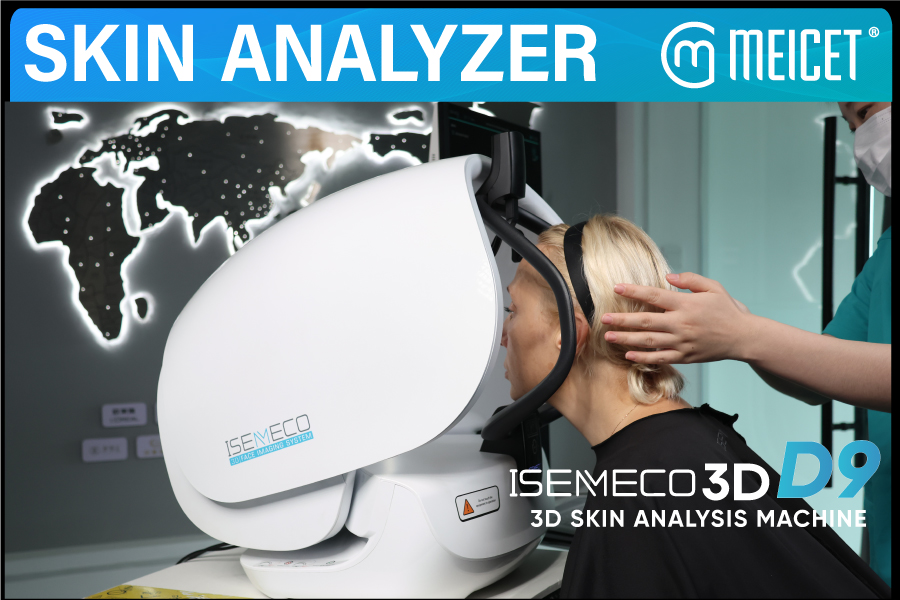The global skin analyzer market has experienced significant growth, driven by advancements in AI, multi-spectral imaging, and 3D reconstruction technologies. These devices are now essential tools in dermatology clinics, aesthetic centers, and even home care, providing precise, data-driven insights into skin health. Leading manufacturers from Europe, North America, and Asia are competing to innovate in this space, with Chinese companies like MEICET emerging as key players. This article highlights prominent global skin analyzer manufacturers, with a focus on China’s representative brands, including MEICET.
01 Global Market Overview: Trends and Leaders
The skin analyzer industry is projected to grow steadily, with the global UV skin analyzer market alone expected to reach $75 million by 2031, reflecting a compound annual growth rate (CAGR) of 4.0%. This growth is fueled by rising demand for personalized skincare and non-invasive diagnostic tools. Key markets include North America, Europe, and Asia-Pacific, with China standing out as both a major consumer and producer.
Globally recognized brands like Courage+Khazaka electronic (CK) from Germany and Cortex from Denmark have set industry standards. CK, with over 40 years of experience, develops instruments that measure nearly all skin surface parameters, widely used in cosmetics, pharmaceuticals, and dermatology. Cortex’s DermaLab Combo, for example, integrates ultrasound, skin microscopy, and multiple probes to assess up to 10 skin parameters, including elasticity, hydration, and pigmentation. These companies dominate in regions like Europe and North America, particularly in clinical and research settings.
02 MEICET: China’s Rising Star in Skin Analysis
MEICET (Shanghai May Skin Information Technology Co., Ltd.) exemplifies China’s rapid advancement in the beauty tech sector. Founded in 2003, MEICET specializes in AI-powered skin analyzers and IoT solutions, exporting to over 50 countries, including Australia, Indonesia, and India. The brand’s success stems from its focus on accessibility, customization, and cutting-edge technology.
Key Products and Features
MC880 Five-Spectrum Skin Analyzer: This flagship device uses five light spectra (daylight, UV, cross-polarized, etc.) to analyze skin concerns like wrinkles, pores, pigmentation, and sensitivity. Equipped with SKIN CLOUD cloud computing and a database of 5 million global cases, it generates precise reports in seconds.
Pro-A and D9 Models: These systems incorporate 3D imaging and AI to simulate treatment outcomes, allowing practitioners to demonstrate potential results to clients. The D9 model also offers multi-terminal support (e.g., iPad compatibility) and cloud-based data management.
Competitive Advantages
AI and Customization: MEICET’s devices use machine learning for symptom extraction and analysis. They also offer OEM/ODM services, enabling clinics to customize software interfaces and hardware designs.
Global Reach: With CE certification and participation in international exhibitions (e.g., AMWC Dubai), MEICET has expanded its footprint across Asia, Europe, and the Middle East.
03 Other Notable Chinese Manufacturers
While MEICET leads, other Chinese companies are making strides:
VISTA: Known for high-precision imaging systems, VISTA’s complexion analysis tools combine polarized, UV, and cross-polarized imaging to visualize subsurface skin issues like pigmentation and vascular concerns. Their devices are widely used in clinical trials.
KonLing: This brand focuses on portable, affordable analyzers, such as the SkinScope, which pairs with mobile apps for on-the-go skin tracking. Its direct-to-consumer model appeals to both professionals and home users.
However, Chinese manufacturers face challenges in brand recognition compared to established Western players. To counter this, they invest in R&D, obtain international certifications, and publish clinical validation studies.
04 Technological Innovations Shaping the Industry
Modern skin analyzers rely on three core technologies:
Multi-Spectral Imaging: Devices like MEICET’s MC880 use up to five light spectra to capture layered skin data, revealing concerns invisible to the naked eye.
AI and Cloud Computing: AI algorithms compare user data against vast databases (e.g., MEICET’s 5-million-case library) to provide personalized recommendations. Cloud storage enables longitudinal tracking and remote consultations.
3D and Simulation Tools: High-end models, such as the D9, create 3D facial maps to quantify volume changes and simulate aesthetic procedures.
05 Future Outlook and Opportunities
The skin analyzer market will continue evolving:
Integration of Multi-Omics Data: Future devices may combine imaging with genetic, microbiomic, and environmental data for holistic skin health assessments.
Miniaturization and Home Use: Brands like KonLing are already shrinking devices into handheld tools, blurring lines between professional and consumer markets.
Augmented Reality (AR): AR interfaces, as seen in MEICET’s prototypes, could overlay analysis results onto real-time reflections, enhancing client consultations.
For Chinese brands, globalization remains a priority. By leveraging cost-effectiveness and innovation, companies like MEICET are poised to capture larger market shares worldwide.
Conclusion
The global skin analyzer landscape is diverse, with legacy European manufacturers and agile Chinese firms driving progress. MEICET stands out as China’s representative innovator, offering AI-driven, customizable solutions that rival international standards. As technology advances, these devices will become more integral to skincare, empowering professionals and consumers alike with precise, accessible insights. For clinics or individuals seeking reliable analyzers, MEICET and other Chinese brands offer compelling options alongside established names like CK and Cortex.
by Irina
Post time: Oct-22-2025










